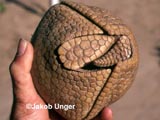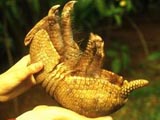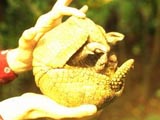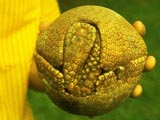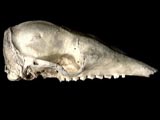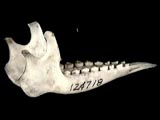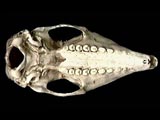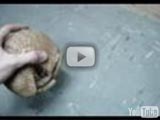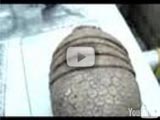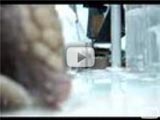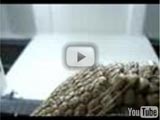Three-banded armadillos
Two species of three-banded armadillos are recognized: The Brazilian three-banded armadillo (T. tricinctus), and the southern three-banded armadillo (T. matacus). Three-banded armadillos are the only armadillo species that can roll into a ball.
Tolypeutes tricinctus
Brazilian Three-banded Armadillo
- Range:
Parts of the northern highlands of Brazil, including the western part of the province of Bahia, Pernambuco, Piauí, Maranhão, and northern Minas Gerais.
- Size and Weight:
Head and body length: 218 — 273 mm (8.6 — 10.7 in).
Tail length: 60 — 80 mm (2.4 — 3.1 in).
Weight: 1.00 — 1.59 kg (2.2 — 3.5 lbs).- Description:
Three-banded armadillos are blackish brown in color. Most animals have three moveable bands, although some possess only two, and others may have four. Members of the genus Tolypeutes are the only armadillos that can completely enclose themselves in their own shell by rolling into a ball. The large front and rear portions of the shell are not attached to the skin on the sides, providing ample free space to fit the head, legs and tail into the shell when the animals are rolled up.
The 2nd, 3rd and 4th toes of the hind foot are grown together, almost like a hoof. The 1st and 5th toes remain separate. T. tricinctus has five on the fore foot. The claws on the forefeet are very strong. Three-banded armadillos generally walk on the tips of the foreclaws, even when running. The tail is short and thick. The diploid number of chromosomes is 2n=38, the lowest of any armadillo studied to date — most other armadillos have 2n=50 to 64. (Humans have a diploid chromosome number of 2n=48, for comparison.)
- Habitat:
T. tricinctus lives in tropical forests on chalky grounds, and in the Caatinga and Cerrado of Brazil.
- Ecology:
When threatened, members of the genus Tolypeutes roll up into ball, leaving only a small opening between the shell edges. If the animal is prodded through the opening, it quickly snaps fully shut like a steel trap. Rolling into a ball appears to be an effective defense against natural enemies.
Three-banded armadillos principally eat beetle larvae, although ants and termites are an important portion of the diet during the dry season (July to November). Insects are obtained by burrowing into ground nests or under the bark of rotting trees. The animals also include a significant amount of fruit in their diet during the wet season.
Three-banded armadillos may be found at densities of up to 7 animals per square kilometer. They are primarily solitary, although groups of up to 12 have been observed sharing the same den site during cold spells.
- Biology:
One young is born per litter; gestation period is about 120 days. Litters are generally born between November and January. The young are born fully formed, resembling miniature adults, and can walk and roll into a ball immediately from birth. Young are weaned at 72 days, and are sexually mature at 9 — 12 months. The IUCN classifies T. tricinctus as vulnerable. T. tricinctus is threatened by habitat destruction. Both species of Tolypeutes seem to be suffering due to overhunting.
- Pictures:
-
Do you have a picture of T. tricinctus that you would like to donate to this site? Please see the Armadillos Wanted page to see how you can help.
Tolypeutes matacus
Southern Three-banded Armadillo
- Range:
Central and eastern Bolivia, the Mato Grasso of central Brazil, Chaco region of Paraguay, northern and central Argentina.
- Size and Weight:
Head and body length: 218 — 273 mm (8.6 — 10.7 in).
Tail length: 60 — 80 mm (2.4 — 3.1 in).
Weight: 1.00 — 1.59 kg (2.2 — 3.5 lbs).- Description:
Three-banded armadillos are blackish brown in color. Most animals have three moveable bands, although some possess only two, and others may have four. Members of the genus Tolypeutes are the only armadillos that can completely enclose themselves in their own shell by rolling into a ball. The large front and rear portions of the shell are not attached to the skin on the sides, providing ample free space to fit the head, legs and tail into the shell when the animals are rolled up.
The 2nd, 3rd and 4th toes of the hind foot are grown together, almost like a hoof. The 1st and 5th toes remain separate. T. matacus has four toes on the fore foot. The claws on the forefeet are very strong. Three-banded armadillos generally walk on the tips of the foreclaws, even when running. The tail is short and thick. The diploid number of chromosomes is 2n=38, the lowest of any armadillo studied to date — most other armadillos have 2n=50 to 64. (Humans have a diploid chromosome number of 2n=46, for comparison.)
- Habitat:
T. matacus is found in grassy or marshy areas between scattered forestland. The animal does not appear to dig its own burrows, but instead uses abandoned anteater burrows as shelter.
- Ecology:
When threatened, members of the genus Tolypeutes roll up into ball, leaving only a small opening between the shell edges. If the animal is prodded through the opening, it quickly snaps fully shut like a steel trap. Rolling into a ball appears to be an effective defense against natural enemies.
Three-banded armadillos principally eat beetle larvae, although ants and termites are an important portion of the diet during the dry season (July to November). Insects are obtained by burrowing into ground nests or under the bark of rotting trees. The animals also include a significant amount of fruit in their diet during the wet season. Three-banded armadillos may be found at densities of up to 7 animals per square kilometer. They are primarily solitary, although groups of up to 12 have been observed sharing the same den site during cold spells.
- Biology:
One young is born per litter; gestation period is about 120 days. Litters are generally born between November and January. The young are born fully formed, resembling miniature adults, and can walk and roll into a ball immediately from birth. Young are weaned at 72 days, and are sexually mature at 9 — 12 months. Some individuals have lived 20 years or more in captivity. T. matacus is the third most common armadillo held in zoos, and has bred successfully in several zoos in the US. T. matacus is designated as near threatened by the IUCN. Both species of Tolypeutes seem to be suffering due to overhunting.
- Pictures:
-
Some images hosted by and © University of Michigan Museum of Zoology Animal Diversity Web; linked with permission.
Do you have a picture of T. matacus that you would like to donate to this site? Please see the Armadillos Wanted page to see how you can help.
- Anatomical Images:
-
Anatomical specimens hosted by and © University of Michigan Museum of Zoology Animal Diversity Web; linked with permission.
- Movies:
Sources
Cardoso da Silva, J.M. and D.C. Oren. 1993. Observations on the habitat and distribution of the Brazilian three-banded armadillo Tolypeutes tricinctus, a threatened Caatinga endemic. Mammalia 57(1): 149-152.
Fonseca, G.A.B., A.B. Rylands, et al. 1994. Livro vermelho dos mamíferos brasileiros ameaçados de extinção. Fundação Biodiversitas, Belo Horizonte. (Cited in Gomes de Oliveira, 1995).
Marinho, J., M. Marques Guimarães, et al. 1997. The discovery of the Brazilian three-banded armadillo in the Cerrado of Central Brazil. Edentata 3: 11-13.
Nowak, R.M. 1999. Walker’s Mammals of the World, 6th edition. Johns Hopkins University Press, Baltimore, MD. 158-168.
de Oliveira, T.G. 1995. The Brazilian three-banded armadillo Tolypeutes tricinctus in Maranhão. Edentata 2: 18-19.
Olmos, F. 1995. Edentates in the caatinga of Serra da Capivara National Park. Edentata 2: 16-17.
Sanborn, C.C. 1930. Distribution and habits of the three-banded armadillo (Tolypeutes). Journal of Mammalogy 11(1): 61-69.
Abbreviations
IUCN: International Union for Conservation of Nature and Natural Resources
USDI: United States Department of the Interior
CITES: Convention on International Trade in Endangered Species of Wild Fauna and Flora
 ] will leave this website.
] will leave this website.



